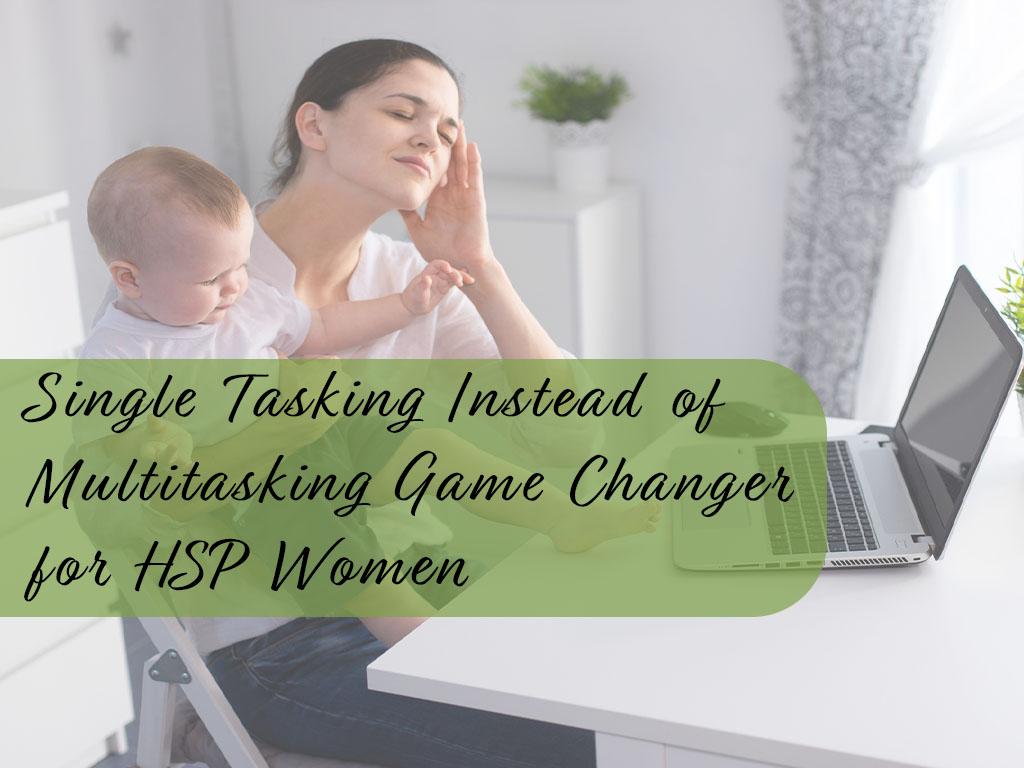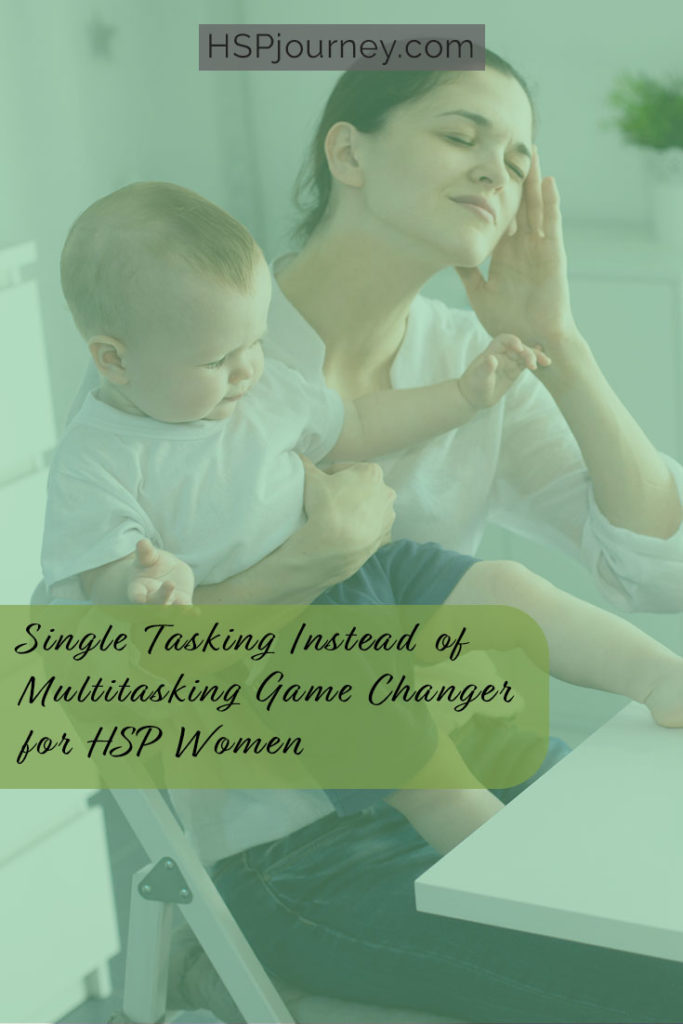If you learn early on in life that multitasking allows you to get more done, you can fall into the trap of feeling like you always should be multitasking instead of single-tasking — no matter what is going on and whether you’re highly sensitive or not.
There’s something in the nature of highly sensitive women and our people-pleasing natures that impact the ways we juggle multiple things at once versus doing one thing at a time. While I do enjoy walking or driving and listening to podcasts, and while I can clean the kitchen while talking to one of my kids about their day, when it comes to high-level tasks that require focused attention and strong concentration, single-tasking wins over multitasking every time.

What is multitasking?
Multitasking is working on more than two things at one time. Multitasking is also switching between multiple projects or tasks repeatedly. Multitasking is also performing a number of tasks quickly, in rapid succession. I know what you were thinking. Yes, motherhood and parenting are perhaps one of the biggest multitasking demands on parents.
Is single-tasking instead of multitasking better?
One study by the Clevland Clinic found that only 2.5% of people were able to multitask effectively. That’s not good for the rest of us 97.5% who probably aren’t multitasking well. So, the simple answer is, most of the time, multitasking is not better than single-tasking. When it comes to those of us who are highly sensitive, we tend toward having difficulty switching gears more than others. We also tend not to like having too many tasks or assignments to keep track of at once. I remember the last two years in college getting my English degree. I had at least five books to reach each week plus multiple papers. It took everything I had to focus on one book and one paper at a time (no kids to distract me back then).
Driving is one task that should be single-tasked for safety. If you have someone with you in the car, put them in charge of the radio controls and map apps. When alone, spend a few minutes getting your mirrors adjusted and your favorite Spotify playlist working before you pull out of the driveway. I can’t tell you how many times I’ve missed my freeway turn-off because I was chatting away with my friend hands-free. Hands-free isn’t the same as single-tasking as I was still carrying on a conversation while driving. If you struggle with concentrating on more than one or two things at a time, I recommend not taking phone calls while driving (I’ll work on taking my own advice).
The more we multitask from one thing to another, the more we divide ourselves for singular focus and true productivity. This is true in business as well as personal pursuits.
What does the research say about single-tasking instead of multitasking?
Research tells us that multitasking isn’t ideal. Often, we switch tasks in quick progression but in essence, we’re quickly performing one task and then another. Not doing more than one thing at once. In 2009, Standford University conducted a research study that found multitasking actually damaged your brain. Other reports claim that our efficiency and accuracy drop significantly when we try to juggle.
Are women better at multitasking than men?
Many people claim that women are naturally better at multitasking. Is it true? Well, it depends on who you ask and what research study you review. Because women often juggle work and family simultaneously (although Covid has challenged this norm), they are perceived as better at men than multitasking. This report from 2019 echoes all the other studies that say neither gender is very good at multitasking.
Tips for Women to Single-Task Instead of Multitask
I had four kids in just under seven years. I know a thing or two about juggling. When my kids were little, I rarely tried to accomplish high-level PR consulting work I did from home while they were awake. It was just too hard to concentrate. Instead, I checked my email first thing in the morning, and made my to-do list. Occasionally I replied to a few emails or did low-level admin-type work here and there when they played. But the real work began when my part-time nanny arrived. I had her come two mornings a week so that I could batch my high-level writing and strategy work. I also worked several evenings a week after my kids were in bed. Naptime provided another good window of opportunity to concentrate without interruption.
Single Tasking Instead of Multitasking Game Changer for HSP Women
When I switched to single-tasking most of the time, I found, as a highly sensitive woman, that I felt more satisfied overall. For me, this looks like grouping similar tasks together to get more done and stay in one frame of mind. When I clean my house, I tend to block three to four hours and do lots of cleaning at once. When I have writing and blogging projects, I like to block off at least an entire morning or afternoon to get more done. I prefer not to switch tasks frequently. I enjoy doing a deep dive into research for a new book or freelance article. If I have to jump up and stop my train of thought, I find myself becoming irritated and discouraged when my productivity plummets.

Looking for an HSP-Trained coach to help you align your life with your priorities?
Through my Highly Sensitive Person (HSP) certification with the Nickerson Institute, as well as being an HSP, I offer HSP coaching to develop specific goals around your HSP needs. We HSPs frequently deal with anxiety and overstimulated nervous systems that prevent us from achieving peace and attaining our life goals. HSP coaching with me includes a detailed review of your sensitivities and a mutually-desired plan for growth and management of this superpower to shift negativity and begin seeing yourself as the hero of your own story. (Affordable monthly coaching begins at $150/month.)
Tips for switching to sing-tasking for high-concentration work when you have young children:
- Trade babysitting hours with another mom for free (drop your child at their house Mondays from 9-11:30 am, you take her kids on Wednesdays at the same time)
- Hire a part-time (or full-time) in-home nanny to help (I always found that having my kids close so that I could pop out and nurse was easier)
- Wake up early and work one or two hours while your kids are still sleeping (for the larks)
- Stay up late and work one or two hours while your kids are sleeping (for the owls)
- Take turns with your partner several nights a week to leave the house and focus on one or two tasks
- Overall, aim to keep your work hours to a manageable amount
- Spend dedicated time with your littles while they want to play tea party, trains, and superheroes
- Involve kids in cleaning, folding laundry, and kitchen tasks (appropriate to age)
- You’ll never regret giving your kids your (mostly) undivided attention
Be sensitive, be free
*This post contains affiliate links and I will be compensated if you make a purchase after clicking on my links*






[…] common to try and multitask when you’re working at home. Whether it’s trying to work on two different projects […]